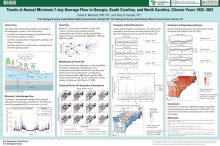Trends of Annual Minimum 7-day Average Flow in Georgia, South Carolina, and North Carolina, Climate Years 1932–2021
Caleb
Mitchell
U. S. Geological Survey
Toby Feaster, U. S. Geological Survey
Poster
Streamflow data are important to water resources managers because they inform decisions that impact water availability, waste management, ecological response to discharges, land use policy, and groundwater pumping. This study analyzed data from 87 streamgages located in Georgia and the Carolinas with at least 30 years of continuous record that have not been substantially impacted by anthropogenic influences and are representative of near-natural conditions. Trends in the streamgage data were analyzed using the non-parametric Mann-Kendall trend test. Streamflow data were evaluated for trend records of 30, 50, 70, and 90 years ending in climate year 2021. All periods were dominated by negative downward trends in the annual minimum 7-day average streamflow. Only the 30-year trend period had a comparable number of streamgages with positive upward trends (40%) as those with negative downward trends (45%). Streamflow trends were likely influenced by climatic cycles such as a wet and cold period (1960s to 1970s), a dry and hot period (2000s to 2010s), and a wet period (2010s to 2020s). Since the annual rainfall totals remained relatively stable and extreme 1-day total precipitation events became more frequent, long-duration low-intensity rainfall events that recharge groundwater and supply baseflow were likely being offset. Some of the largest and strongest upward streamflow trends may have been in response to localized increased annual rainfall. Managers can use this trend data to identify priority watersheds that may require more intensive management and monitoring to balance water availability and quality during periods of droughts.
Poster PDF

Meeting homepage